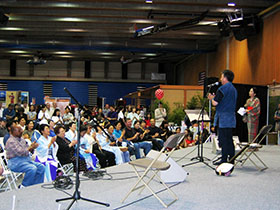| Back
to previous page |
~Past Event ~ 2004 Information |
Tsugaru Shamisen Performer, Mr. HIROSHI MATSUDA (Third-generation Grand Master, Rinshuei Kida) |
| THIRD-GENERATION GRAND MASTER RINSHUEI KIDA - PROFILE |
|
|
"Photos courtesy of Mr. Matsuda" |
Mr. Hiroshi Matsuda (his birth name) was born in 1947 in Hokkaido, the northernmost island in Japan. After graduating from high school in Hokkaido, he moved to Aomori prefecture, the region and birthplace of Tsugaru Shamisen music, in the northern part of Japan's main island of Honshu. Since 1963, he has served as a policeman in Aomori prefecture and he continues to be a serving citizen of Aomori today. Mr. Matsuda started studying Tsugaru shamisen 22 years ago as an apprentice of the first grand master of Rinshuei Kida and became the 3rd Grand Master Rinshuei Kida in 1998. Currently he is teaching shamisen, and performing in many areas in Aomori. One of the unique styles of his playing is called tataki shamisen, which means using a large plectrum for striking and plucking the strings, similarly to a percussion beat, and playing melodies at the same time. One of the unique sounds of playing Tsugaru shamisen is improvisation like jazz music, which becomes a free interpretation of the sound. The player plays around original melodies and ad-libs around the music structure, in a sense that becomes more of a free style of the individual's sound. Mr. Matsuda's passion for playing Tsugaru shamisen will continue after his early retirement from the police department in a couple of years. After his retirement, he would like to devote his time to performing and also teaching, not only in Japan, but in foreign countries as well to bring them the exciting sound of Tsugaru shamisen. |
| A BRIEF HISTORY OF SHAMISEN AND TSUGARU SHAMISEN |
Traditional three-stringed plucked lute instruments called shamisen, and samisen music, were developed as a new instrument in Japan around the time of the sixteenth century through the nineteenth century, and mostly were played in the theater as an accompaniment rather than as a lead instrument. Tsugaru shamisen was developed among the Bosama, blind itinerant performers in the Tsugaru region, starting at the end of the Edo era approximately 120 years ago. Bosama entertained throughout the year, performing in small villages to which they traveled by foot. Tsugaru shamisen developed and eventually emerged as a solo instrument. |
| Hosting Provided by Pacific Software Publishing, Inc. Copyright © 1998-2015 ENMA |
Back
to Top
|
|

